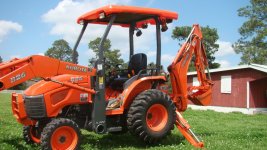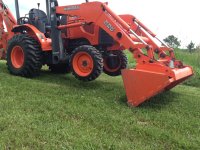PatasColo
Silver Member
- Joined
- Nov 23, 2010
- Messages
- 236
- Location
- Front Range of Colorado, USA
- Tractor
- Kioti CK20S HST and Gravely walk-behind (2 wheel tractor - 700 lbs.).
My Kioti CK20S with backhoe is fairly new to me. As I go to set up for backhoe usage, the front wheels are s'posed to get raised just off the ground by putting down the FEL bucket (lip tipped slightly down to dig in if there is movement).
Some ground around my place is solid sandstone rock layers, and lots of variation in angles/slopes. I find it is not uncommon that one side of the FEL may touch ground/rock an inch or two before the other side. I've been repositioning to avoid this, but I'm concerned for a time when it can't be done (i.e. a tight spot that needs digging has wonky rock layers all around). It torques the FEL arms and might bend something in bad ways, even if only slightly (for example, so that if I ever removed the FEL, it might be impossible to get back on).
Any comments or experience with this? Suggestions, aside from avoiding it as much as possible?
-Mitch
Some ground around my place is solid sandstone rock layers, and lots of variation in angles/slopes. I find it is not uncommon that one side of the FEL may touch ground/rock an inch or two before the other side. I've been repositioning to avoid this, but I'm concerned for a time when it can't be done (i.e. a tight spot that needs digging has wonky rock layers all around). It torques the FEL arms and might bend something in bad ways, even if only slightly (for example, so that if I ever removed the FEL, it might be impossible to get back on).
Any comments or experience with this? Suggestions, aside from avoiding it as much as possible?
-Mitch

